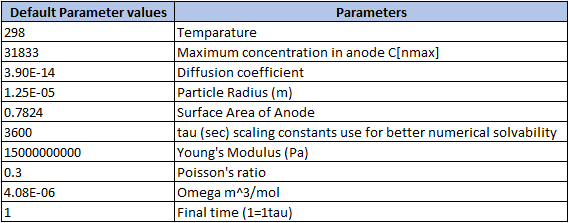Would you like to know if your material can be used without causing significant capacity fade due to intercalation induced stresses? Would you like to know how to charge your battery based on its material property? If so, this paper ( Optimal charging profiles for mechanically constrained lithium-ion batteries ) and the code (find here ) given can be used by just downloading the files from the link given and running it on any Windows PC.
Ever-increasing demands for vehicle electrification have forced auto manufacturers to investigate energy storage materials which are superior to conventional lithium ion chemistries. Novel materials with high gravimetric and volumetric capacities (like silicon, germanium etc.) are being pursued as potential candidates to replace traditional graphite anodes in lithium ion batteries. However, these materials exhibit significant volume changes and stress development which leads to mechanical degradation and capacity fade.
To address such difficulties and to ensure safe operation of batteries, model based control strategies can be utilized. During lithium intercalation/de-intercalation, the stress development within the particle affects the concentration gradients. Fickian diffusion is unable to capture these dynamics and pressure induced diffusion must be included. Several research groups (e.g. Professor Newman’s group at UC Berkeley, Professor Sastry’s group at the University of Michigan, Professor White’s group at the University of South Carolina, Dr. Mark Verbrugge’s group at General Motors ) have developed physics based models to simulate pressure induced diffusion, stress development, volume changes, etc.
In our work titled “ Optimal charging profiles for mechanically constrained lithium-ion batteries ” ( DOI: 10.1039/C3CP52806E), we have shown how stress generation during charging can be minimized by optimizing the charging protocol. The charging protocol minimizes the stresses generated to reduce capacity fade. To our knowledge, this is the first code in literature that can be used to identify optimal charging protocols for any given material.
The code is provided in executable form, with material properties editable in the text file. The code given can be used for any material. List of all the parameters that needs to be provided for specific material can be found in “parameters.txt” (included in the package). The same set of parameters is given below. The code hosted in our website derives a charging profile to maximize the amount of charge in a given time while restricting the peak stresses generated at center and surface of the particle. The code given should be viewed as providing an initial estimate for an optimal charging profile. Other important phenomena, such as volume changes, require more detailed models, simulated in efficient form, which are not included here. A recent paper from our group (titled “ Efficient Reformulation of Solid Phase Diffusion in Electrochemical-Mechanical Coupled Models for Lithium-Ion Batteries: Effect of Intercalation Induced Stresses ”) demonstrates efficient reformulation of pressure induced diffusion in lithium-ion battery electrode particles for mechanical–electrochemical coupled models which significantly reduces computation times.
Uddate: 02/12/14. For later versions of windows based computers (64 bit operating systems), the code given may not work. If so, please contact us, we will send a compatible exe file.
List of Parameters:

